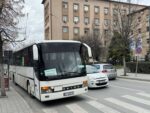For the fifth consecutive night, police in Serbia have clashed with protesters in several cities across the country. Serbian Interior Minister Ivica Dačić stated at a press conference in Belgrade, shortly before midnight, that there had been “drastic violations of public order.”
The most violent confrontations were reported in Valjevo, in western Serbia, after the offices of the Serbian Progressive Party (SNS) – the party of President Aleksandar Vučić – were set on fire.
Similar incidents have occurred in recent days in many other cities, including the capital, Belgrade.
Dačić noted that in Valjevo, the courthouse, prosecutor’s office, and municipal administration buildings were also attacked. Additionally, the offices of the Serbian Radical Party – a far-right party led by war criminal Vojislav Šešelj – suffered significant damage.
Videos from the scenes show police officers using tear gas, stun grenades, and dispersing protesters who threw objects in their direction.
A similar scenario occurred in Belgrade, where protesters gathered in front of Vučić’s party headquarters but were later dispersed by police using tear gas.
The clashes erupted following the publication of several photos on social media showing young individuals who had been detained in recent days in Novi Sad. In the images, they are seen kneeling with their backs to police officers at the moment of arrest.
Police have neither confirmed nor denied the authenticity of these photos and have not stated whether an investigation into potential police misconduct will be launched.
In Valjevo, protesters were heard shouting, “Don’t beat our children,” and calling for the release of all detainees.
Dačić, on the other hand, said at the conference that police had faced continuous attacks. He warned that “all those spreading false information” would be arrested, referring to inaccurate social media reports alleging the “death of a protester.”
The protests are organized via social media and are led by groups identifying themselves as student organizations.
These groups have been at the forefront of protests in Serbia since November of last year, initially demanding political and criminal accountability for the deaths of 16 people following the collapse of a concrete shelter at the Novi Sad railway station.
Later, the protests expanded to call for anti-corruption measures and early parliamentary elections—a demand rejected by the government.







